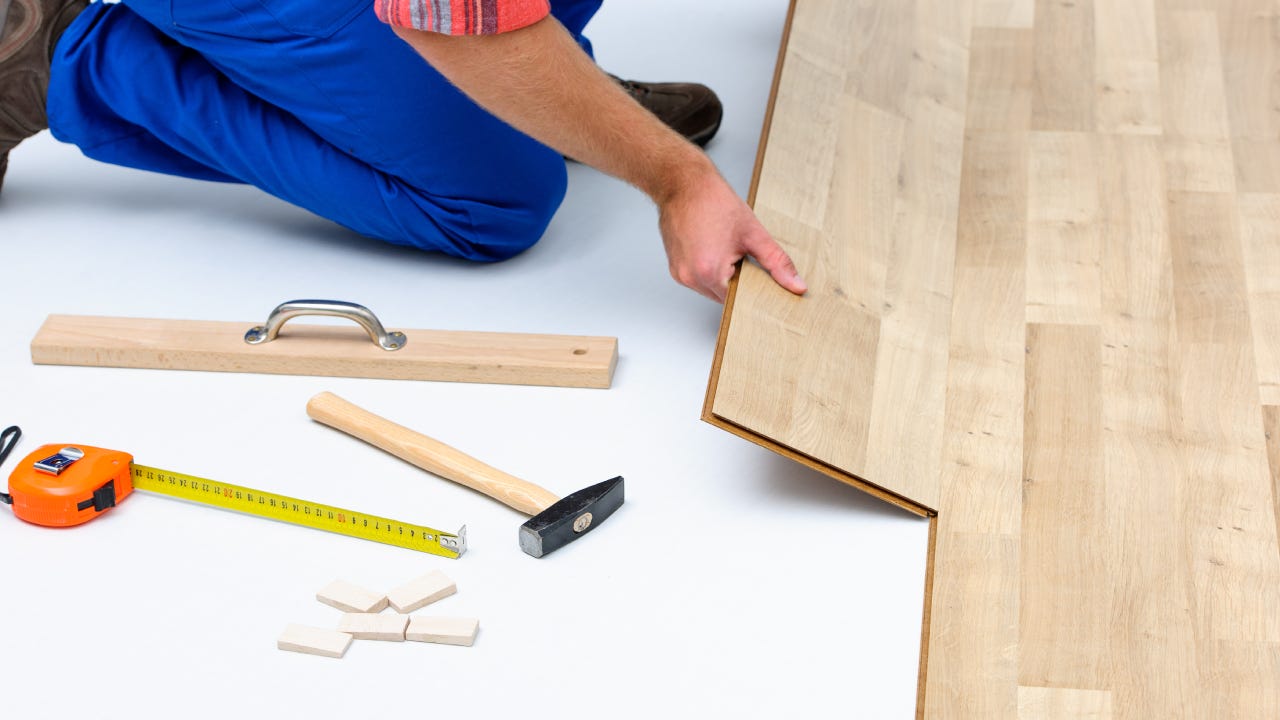How much does it cost to install laminate flooring?

The Bankrate promise
At Bankrate we strive to help you make smarter financial decisions. While we adhere to strict , this post may contain references to products from our partners. Here's an explanation for .
If you’re building or renovating a home but don’t want to blow your budget on the floors, we have one word for you: laminates.
Laminate flooring is a snazzy synthetic, usually designed to look like wood, though it can mimic stone or tile too. Easy to install and maintain, it costs far less than floors made of natural materials.
The average tab to lay down laminate flooring runs between $1,500 and $3,500 or $6 and $14 per sq.ft., including both labor and material costs, according to Adam Graham, an industry analyst at Fixr.com. Genuine hardwood floors cost virtually double that.
However, your exact laminate flooring cost will vary depending on a few factors, including the type you choose and the condition of your existing floors. Here’s what to know before deciding to install laminate floors in your house.
Key takeaways
- Laminate flooring is designed to look like hardwood (or other traditional flooring materials) but is more affordable and easier to install.
- Installing laminate floors usually costs between $1,500 and $3,500.
- Laminate floor costs depend on the laminate type, the complexity of the project and any additional tasks required, like carpentry or subfloor repairs.
- Depending on your existing flooring and your appetite for DIY projects, you might be able to install laminate floors yourself.
What is laminate flooring?
Laminate floors are composed of a series of tiles or planks. Each one is made of several layers that are fused together. There’s a particle board base at the bottom and above it, an image layer: a high-definition printed photograph of wood, tile or whatever material you’d like. On top, there’s a clear layer of plastic, which seals in and protects the layers below it.
Some laminate floors come with their own underlayment, others need a separate one — usually made of cork — installed beneath them, to provide cushioning.
Laminate floors come in different degrees of thickness — between 6 and 12 millimeters (generally, the thicker, the better quality). They can be textured in various ways, from perfectly smooth to high scraped, and finished to look glossy, matte or something in between.
One of the biggest differences homeowners will notice between hardwood floors and laminate flooring is the cost to install them,” says Fixr.com’s Adam Graham. This cost difference can be significant, with hardwood floors costing nearly twice as much as laminate flooring, according to Fixr data — around $2,800 to $6,400, vs $1,500 to $3,500 for a laminate lookalike.
The disparity reflects the composition of the two floors, and the fact that one is manufactured, while the other is natural. “Laminate flooring is made of synthetic layers to give the appearance of wood, whereas hardwood is the real deal, consisting of solid planks,” says Graham.
Since they’re designed differently and made from different materials, laminate floors don’t look exactly like hardwood floors. Though the better-quality models can come close, “hardwood flooring is unmistakable in its classic and authentic appearance,” says Graham. “Laminate flooring, while having many positive qualities, does not match up in aesthetics.”
Calculating the cost to install laminate flooring
From the size of your home to local labor costs, several variables will affect how much you pay for laminate flooring.
Floor type
Laminate doesn’t just imitate wood, it imitates different varieties of wood. Interestingly, the more expensive natural woods are also the more expensive laminates, because the nuances of their graining and color make them harder to duplicate. If you’re trying to achieve a certain kind of look, you may need to pay more.
According to Fixr.com, the cheapest styles of laminate include acacia, beech and oak, each of which begins at around $1 per square foot (not including installation costs). Elm, maple and hickory are mid-range styles, starting at around $1.50 per square foot. Walnut is the most expensive, starting at $2 per square foot. These “wood” prices in general max out around $4 – $4.50 per square foot.
While wood laminate flooring is the most common (and affordable), there are also other types to consider. The more unusual stone variety, which imitates a repeating pattern of tumbled or antiqued stones, costs a bit more. Tile laminate floors are the most expensive of the bunch.
Cost to install by laminate types
| Laminate style | Cost range per sq. ft. (material only) |
|---|---|
| Wood | $1.50-$3 |
| Stone | $3.50-$4 |
| Tile | $3.50-$5 |
Source: Fixr.com
Flooring area and shape
As you might expect, the size and shape of your floors also impact your project cost. In general, the larger your space, the more you’ll pay for flooring and installation. For instance, it would cost an average of $600 to $1,400 to add laminate floors to a 100-square-foot room, $3,000 to $7,000 for a 500-square-foot room, and $6,000 to $14,000 for a 1,000-square-foot room.
Also, if you have a uniquely-shaped room, your installer may need to spend more time custom-fitting the laminate flooring to your space – which can increase your costs for labor and possibly materials as well.
Labor
Labor accounts for a substantial portion of the overall cost to install laminate flooring, which runs $4 to $8 per square foot. For a typical 200-square-foot project, which costs between $1,500 and $3,500, you could expect to pay around $1,000 to $2,000 for the installers.
Geographic location
Finally, you’ll need to consider your location when calculating laminate flooring costs. “Where you live will also affect the final price, as material costs vary from state to state,” says Graham — as of course do workers’ wages. Before beginning your project, reach out to several installers to see how much their prices vary.
Additional costs and considerations
Depending on the condition of your floors and the aesthetic you’re hoping to achieve, you might also need to think about these additional costs.
Removing old flooring
It’s possible to add new laminate flooring over some kinds of existing floors, but if you have carpet or hardwoods, you’ll need to remove them first. Flooring professionals typically charge about $70 per hour to remove old floors, for a total cost of $400 to $600, according to Angi.
Subfloor repair or replacement
Before installing laminate floors, you’ll need to ensure that your subfloor is level and in good condition. If it’s not, a repair or replacement could add an extra $400 per 200 square feet, according to Angi.
Warranty
The length of your laminate flooring warranty will depend on your manufacturer, but most have at least a five-year warranty, with some even including a lifetime warranty. Just be sure to check your manufacturer’s policies so that you don’t mistakenly void your warranty, which could happen if you install or clean your floors incorrectly.
AC rating
Laminate floors have an abrasion class (AC) rating, which measures their durability on a scale of one to five. According to HomeGuide, lower-rated laminate is intended for light residential usage (like in closets and bedrooms), while higher-rated laminate is suitable for more heavily trafficked rooms or areas.
Pad and underlay
You’ll likely need underlayment between your subfloor and laminate flooring as a way to protect the flooring and reduce noise. Every 100 square feet of underlayment costs between $30 and $60, in addition to labor costs of $70 per hour, according to Angi. Some types of laminate flooring already have underlayment attached, but your installer may recommend a separate layer.
Texture
In addition to the plethora of styles, there are also different textures of laminate flooring, ranging from smooth (on the cheaper side) to handscraped (on the pricier end). Costs range from $1.69 per square foot to $5.99 per square foot, depending on the aesthetic you’re going for.
Thickness
When picking out laminate flooring, you can choose from several thickness levels. In general, thicker planks are more likely to resist bending and warping – but they’re also more expensive. You can find 6mm laminate floorboards around $0.69 to $0.99 per square foot, while 12mm will cost roughly $2.29 to $5.99, per Fixr.com.
Finish
Like texture and thickness, you’ll also have the option to choose the finish on your laminate flooring. Semi-matte finishes are the most affordable, starting at around $1 per square foot. If you’re aiming for a more polished look, you can opt for a gloss finish, which starts at $1.69 per square foot.
Pros and cons of laminate flooring
Like any other renovation project, there are positives and negatives to installing laminate flooring.
Pros
- Easy to install, clean and maintain
- Cheaper than natural-material floors
- Available in countless styles and designs
- Some types are scratch-resistant
- Can be installed over existing floor
Cons
- Less durable than a wood or stone floors
- Your subfloor must be in perfect condition
- Can’t be refinished
- Adds little to home value
- Not recommended for humid/wet/below-grade areas or rooms
What are floating floors?
You may hear laminate floors referred to as “floating floors.” This means that they click and lock into place — they don’t need to be glued or nailed to your subfloor. That’s one reason they’re so easy and cheap to install. Most contemporary laminate floors float, though they can be nailed or glued if that’s better for the subfloor.
Should you DIY installing laminate floors or hire a professional?
Laminate flooring is very DIY-friendly, thanks to its floating design and ability to be installed over certain kinds of existing flooring. According to Fixr.com, amateurs can laminate an entire floor within a day. Of course, professionals would probably be even quicker. You might also prefer to go pro for some reason you can’t click and lock the floor, but need it to be glued or nailed, or if your subfloor needs repair. You might also want a carpenter to install baseboards (laminates can’t be installed up to the wall edge — an expansion space must be left for them to swell a bit).
How to save money on the cost to install laminate flooring
Since labor accounts for so much of the cost to install laminate flooring, you can save quite a bit by installing it yourself. At the least, you can do a lot of prep (removing carpeting and existing baseboards) and clean-up, if workers are charging by the hour. Other ways to save include opting for more budget-friendly wood-floor types (like oak) and less flashy textures and finishes.
Questions to ask about the cost to install laminate flooring
Before hiring an installer, it’s important to vet them thoroughly. Here are a few questions to ask during the interview process.
- Are you insured?
- Do you have customer references?
- Can you show me pictures of similar projects you’ve completed in the past?
- What’s the timeline for this project?
- What’s included in the estimate, exactly?
- What are my payment options?
The bottom line on installing laminate floors
For those looking to replace floors fast fast or save money, laminate flooring can be an innovative alternative.
On the plus side, a laminate floating floor is cheaper and easier to maintain than genuine hardwood – especially if you have kids or pets. You may be able to install it yourself. And, as imitations go, it can look amazingly good.
However, it won’t ever appear as high-end as the real thing. It’s not an investment in your home, it won’t improve the resale value and it certainly won’t be a selling point. On top of that, laminate floors usually don’t last as long as hardwood, and you can’t restore or refinish them, so you might have to replace them earlier than you would with authentic wood. They also need to be in dry, above-grade spaces or you risk warping and buckling.
In short, it’s a quality quick fix. So, ultimately, deciding whether or not laminate floors are right for you is a matter of budget, lifestyle and personal preference.
Related Articles



